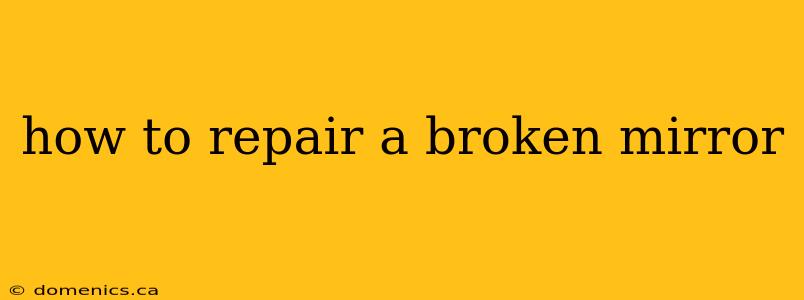Meta Description: Learn how to repair a broken mirror! This comprehensive guide covers everything from assessing the damage to choosing the right adhesive and techniques for a seamless repair. Get expert tips for restoring your favorite mirror to its former glory, no matter the severity of the break. Save money and keep sentimental pieces!
Mirrors, whether antique heirlooms or modern accents, can add elegance and functionality to any room. A broken mirror, however, is more than just an inconvenience; it can be a frustrating and potentially hazardous situation. This guide will equip you with the knowledge and techniques to repair your broken mirror, saving you money and preserving cherished reflections.
Assessing the Damage: First Steps in Mirror Repair
Before you begin, carefully assess the extent of the damage. This will determine the best repair method and materials needed.
1. Type of Break:
- Small Chips or Cracks: Minor damage is often the easiest to repair.
- Large Cracks or Shattered Pieces: More extensive damage requires more care and potentially specialized tools.
- Completely Shattered Mirror: For severe breakage, professional assistance might be necessary. Safety is paramount; shattered glass is dangerous.
2. Location of the Break:
The location of the break influences your repair strategy. A crack in the center might be easier to manage than one along the edge.
3. Mirror Type:
Consider the type of mirror. Is it framed or unframed? Is it a standard plate glass or a specialty mirror?
Gathering Your Supplies: Essential Tools and Materials
Once you've evaluated the damage, gather these essential supplies:
- Safety Glasses: Protecting your eyes is crucial when working with broken glass.
- Gloves: Wear gloves to prevent cuts and handle the glass safely.
- Clear Epoxy Resin or Mirror Repair Kit: Choose a strong, clear adhesive designed for glass. Specialized kits often include additional tools and instructions.
- Clean Cloth or Paper Towels: Essential for cleaning the broken surfaces.
- Small Paintbrush or Applicator: For applying the adhesive precisely.
- Masking Tape: For holding pieces in place while the adhesive dries. Consider using artist's tape for less residue.
- Clamps or Weights (Optional): For larger pieces, clamps or weights can ensure proper alignment during drying.
Repairing Your Broken Mirror: Step-by-Step Guide
1. Clean the Broken Surfaces: Use a clean, soft cloth to remove any dust, debris, or loose glass fragments. Thoroughly clean the areas where the adhesive will be applied.
2. Prepare the Adhesive: Follow the manufacturer's instructions for preparing the epoxy resin or adhesive from your repair kit. Mixing ratios are critical for proper curing.
3. Align and Secure the Pieces: Carefully align the broken pieces as accurately as possible. Use masking tape to secure them temporarily. Be gentle to avoid further damage.
4. Apply the Adhesive: Use a small paintbrush or applicator to apply a thin, even layer of adhesive to the broken edges. Avoid excessive adhesive, which can cause bubbles or cloudiness.
5. Clamp or Weight (If Necessary): For larger pieces or more significant breaks, use clamps or weights to hold the pieces firmly in place while the adhesive sets. Ensure even pressure to prevent warping.
6. Allow Sufficient Drying Time: Follow the manufacturer’s instructions carefully for drying time. This usually ranges from several hours to 24 hours, depending on the adhesive and environmental conditions.
7. Remove Tape and Clamps: Once the adhesive is fully cured, carefully remove the tape and clamps. Inspect the repair for any imperfections.
8. Optional Refinishing: For very noticeable repairs, you might consider lightly sanding and polishing the area to achieve a smoother finish.
Troubleshooting Common Issues
- Cloudy Appearance: This might be caused by excessive adhesive or air bubbles. Try using less adhesive and applying it more carefully next time.
- Uneven Repair: Use clamps or weights for better alignment during drying.
- Loose Pieces: The adhesive may not have fully cured. Ensure you followed the manufacturer’s instructions for drying time.
When to Call a Professional
While many minor mirror repairs can be tackled at home, some situations warrant professional assistance:
- Severely shattered mirrors: Safety is paramount. Professional removal is safest for severely broken mirrors.
- Antique or valuable mirrors: Specialized repair techniques may be required for fragile or antique mirrors.
- Large mirrors: Handling large broken mirrors can be difficult and potentially hazardous.
Repairing a broken mirror can be a satisfying DIY project, saving you money and preserving a cherished item. By following these steps and prioritizing safety, you can restore your mirror to its former glory. Remember, always prioritize safety and don't hesitate to call a professional if you're unsure about any aspect of the repair.
